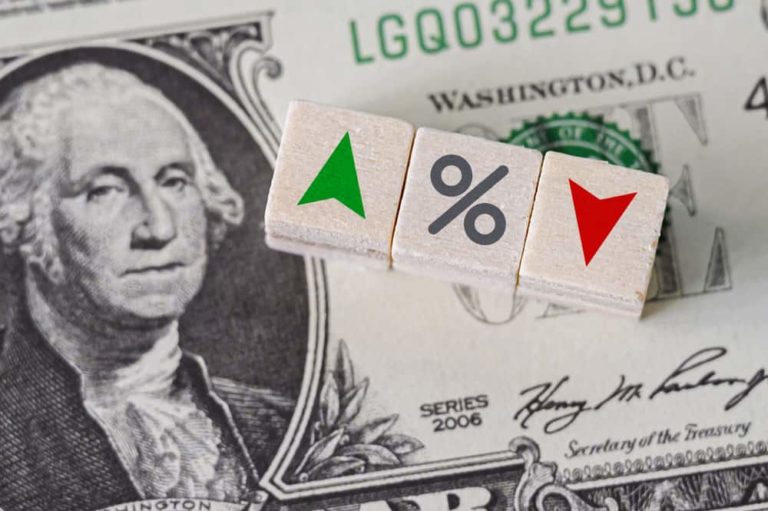By Edward Moya
US stocks rallied Thursday after recession risks eased following better-than-expected GDP data.
The data was good news that was able to send stocks a little bit higher, but not all the way as rate cut bets were pared back.
For stocks to have a sustained rally, we still need a recession and this data is delaying hopes of that happening before the middle of the year. A recession will help get the job done bringing inflation all the way down, otherwise a tentative soft landing will just keep Fed policy restrictive.
Wall Street is having a sugar crash as Thursday’s rally will fade quickly.
Less aggressive Fed
The end of global tightening is almost here.
First, it was a signal of a potential pause from the Bank of Canada, then it was a smaller-than-expected rate hike from the South African central bank. Central banks expect disinflation trends to remain firmly in place and they are nearing the end of their respective aggressive rate hiking campaigns.
The Fed is watching the other central bank rate decisions and the chances of a half-point rate rise seem very unlikely now. The Fed will look at the latest round of data most likely downshifting to a quarter-point pace, but because the labour market remains strong, they will stand by their dot-plot forecast and signal hikes could continue.
US Data
The US economy didn’t lose that much momentum in the fourth quarter.
Economic growth cooled to a 2.9% annual rate, which was better than the 2.6% consensus estimate. Personal consumption declined from 2.3% to 2.1% and missed the 2.9% forecast. Core PCE q/q dropped from 4.7% to 3.9%, but everyone will wait to see what happens with Friday’s release of the Fed’s favourite inflation gauge.
The economy is supposed to be decelerating, but a lot of the key data points aren’t supporting that argument. Weekly jobless claims continue to deliver some very robust prints that suggest the labour market is ready to break.
Monetary policy will start to feel restrictive soon and claims will rise, and GDP should still contract by mid-year.
Durable goods orders for December also impressed with a 5.6% gain, more than double of expectations. Weakening capital goods orders is a bad sign for manufacturing activity, but recent regional surveys have suggested a soft patch was here.
Until the labour market shows actual signs of weakening and not just planned layoff announcements, stocks will struggle to form a sustained rally.
Tesla
Tesla is getting the job done. The electric car giant posted strong earnings and revenue beats.
The news was not all positive as they missed on free cash flow. Berlin and Austin manufacturing has ramped up and they could be able to maintain their previous guidance for average annual growth of 50% over multiple years.
For 2023, they are only guiding a 37% increase in production to 1.8 mln vehicles a year.
Chevron
Chevron’s earnings will happen on Friday, but that didn’t stop them from announcing a $75 bln buyback.
Last year was a record year for the oil giant and no one should be surprised that they are able to increase their buyback plan. This buyback decision will clearly anger the White House, especially if they don’t show an increased investment in CAPEX on Friday.
Airlines
Airlines went as expected as Southwest was crippled by the 17,000 cancelled flights at year-end and the others had some struggles with domestic travel.
American Airlines posted better-than-expected profits as they were able to charge more and capitalise over strong travel demand.
JetBlue’s profit was a beat but investors are a little downbeat on the outlook for domestic travel going forward. CEO Geraghty noted, “we’re pleased to see the demand environment remain solid into the seasonally tough period of the year.”
The airlines still have strong demand and business travel has improved, but the big question mark is how quickly will demand deteriorate as we head towards a recession.
Oil
Crude prices got an unexpected boost from a US economy that doesn’t want to break.
Another round of US data supported the argument that this economy still could get a soft landing, which is very positive for the short-term crude demand outlook. The problem for the long-term growth outlook for the US economy is that it needs a recession in order for inflation to get tamed.
Strong data is not necessarily good news for winning the war against inflation and that will weigh on long-term US growth prospects.
Improving news with China’s COVID situation and a resilient US economy should keep oil prices supported above $80.
Gold
Gold is softening as better-than-expected US GDP data supports the argument that the Fed could still deliver a soft-landing.
Gold’s rally was on hold until the FOMC decision, so Thursday’s weakness to strong GDP and jobless claims data was an easy trade. Safe-haven demand is still needed as the consumer is clearly weakening here and we will probably need to wait a little longer for GDP and claims data to catch up.
Crypto
Bitcoin pared losses as soft-landing hopes returned following better-than-expected US GDP data.
Bitcoin still looks poised to consolidate here until next week’s FOMC decision.
One notable crypto story was a fine given to Coinbase by the Dutch central bank. The penalty is from offering crypto products prior to their registration. This $3.6 million fine is a slap on the wrist, but another reminder that a global crackdown on crypto continues.
Edward Moya is Senior Market Analyst, The Americas at OANDA
Opinions are the author’s, not necessarily that of OANDA Global Corporation or any of its affiliates, subsidiaries, officers or directors. Leveraged trading is high risk and not suitable for all. Losses can exceed investments.







